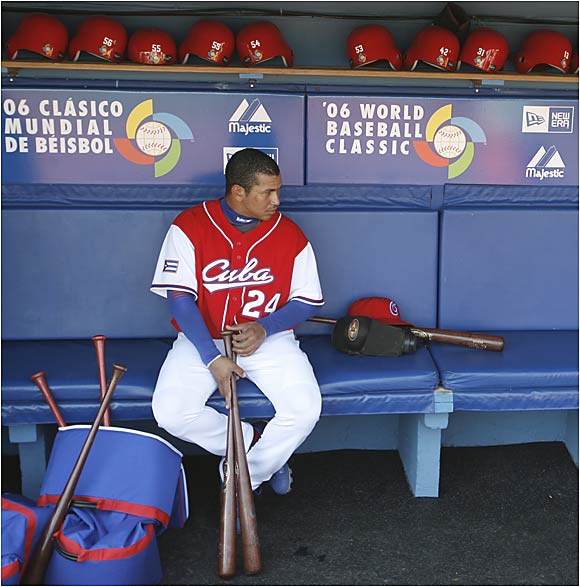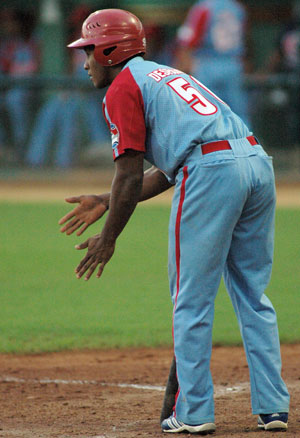Eyes on Cuba for WBC II
By PETER C. BJARKMAN*

HAVANA TIMES, March 4- An inaugural World Baseball Classic unveiled to North American fans a supply of Cuban League all-stars most aficionados north of Miami had never previously heard of. It is a safe bet that the tournament’s second edition promises more of the same.
In March 2006 Yulieski Gourriel, Ariel Pestano, Frederich Cepeda and Pedro Lazo proved to a skeptical outside world that the isolated Cuban League indeed did feature plenty of ballplayers who could perform admirably at the big league level.
Cuba’s run to the WBC championship game also put an end, once an for all, to the worn-out myth that Cuba only won all the big international Olympic-style baseball matches because they were always facing unprepared American and Asian collegiate squads, instead of true top-level professionals.
The myth may now be dead and buried, but Cuba’s top stars are still surrounded by an air of mystery and a cloud of obscurity. This is especially so for those whose baseball fare is restricted to the version of the sport marketed by the highly profitable corporation known as Major League Baseball.
Cepeda and Gourriel, along with Pestano and Paret and a host of similar veterans, will now be back to display their wares a second time in Mexico City, and likely also in San Diego. Freddie Cepeda is still at the top of his game and Yulieski Gourriel remains one of the lynchpins of the Cuban offense.
The pair were both named to Baseball America‘s published listing of the “the top ten prospects not affiliated with Major League Baseball” at the conclusion of the last Classic. And I myself have written in numerous publications over the past five years that if I were ask to pick half-a-dozen Cuban national stars that would star for any major league outfit, my list would begin with outfielder Cepeda, catcher Pestano and closer Pedro Lazo.
The switch-hitting Cepeda is rarely at the top of individual Cuban League leaders in any category of offensive statistics. Yet he remains the perfect combination of awesome slugging power from both sides of the plate, incredible strike zone discipline and patience at the bat, and a knack for rising to superb performances in the most crucial games. While most of the Cuban outfield has been revamped since the 2006 WBC, Cepeda is the one remaining constant.
Cepeda’s previous Classic performance including the game-deciding homer against Venezuela that launched Cuba’s run to San Diego, as well as the late-inning blast during the championship match which lifted his team back into the game versus Japan. When the chips are down for Team Cuba next week in Mexico City, Cepeda is one proven all-star that big-league fans and opponents alike would be well advised to keep their eyes on.

But it may be a half-dozen or so new faces that will grab much of the attention for Team Cuba this time around. For starters there are a couple of young pitchers named Aroldis Chapman and Vladimir Garcia that are almost certain to turn the heads of innumerable scouts and impressionistic television viewers.
Twenty-year-old Chapman enjoyed a brief moment in the international limelight during the 2007 Taiwan World Cup, before temporarily fading from the scene, mainly due to his recent inabilities to control an unrivaled fastball. But this season the Holguín lefthander has rebounded with a vengeance. He has struck out 89 league batters in only 74 innings, and his “heat” was clocked at 102 mph in a December game in Las Tunas. Ciego de Avila right-hander Garcia, also only twenty, has saved 17 games in his 22 appearances this winter and is seemingly destined to soon replace the better-known Lazo as Cuba’s ace late-inning reliever.
Another newcomer likely to impress is Villa Clara’s fleet young outfielder Leonys Martin, a defensive stalwart and productive batsman who will be getting his first test on the national team level, during what could be Cuba’s biggest international showcase event ever.
Last winter Martin remained locked in a season-long tussle for the league hitting title with Yoandy Garlobo, one of Cuba’s biggest offensive threats during the first Classic. Martin missed out by only a couple of base hits on finishing with an eye-popping .400 average, and also failed by less that .001 percentage points to edge out Garlobo for the batting crown.
However it is a pair of emerging young sluggers from Granma Province, one of the Cuba League’s weakest teams, who are the best bets to open North American, Asian, and European eyes. Alfredo Despaigne (pronounced Deh-Spain) already made a splash with his clutch slugging in Beijing. Yoennis Cespedes will be getting his first shot at the big time after waiting in the wings as a budding prospect since he was mentioned as a 19-year-old possibility for the first Classic roster. Between them the pair slugged 50 homers last season, the first duo of Cuban League teammates ever to accomplish that feat.
I alluded in my previous diary entry to how Cuba seems to constantly uncover new ball-playing talents to replace any possible departures from its national squad, whether those departures result from abandonment (Maels Rodriquez, Kendry Morales, Alexei Ramirez, and most recently Yadel Marti ) or from inevitable aging (Osmani Urrutia, Yoandy Garlobo, and perhaps soon Pestano and Paret). This year’s Classics team proves to be one of the best examples to date of this remarkable Cuban baseball revitalization phenomenon.
Cuba’s contingent of young stars will certainly have their work cut out for them in Mexico City, and latter San Diego and maybe even Los Angeles. The burning question for Cuban fans is whether or not enough of them have the raw talent or vital seasoning to stand up to the big league level of performance in a star-studded tournament that is a notch above the Olympic venue.
But one thing is quite certain. Win, lose or draw, we should see some remarkable Cuban ballplayers on display over the next two weeks. For those of us who follow the Cuban league closely, their performances should be an affirmation and a justification for our own enthusiasms about Cuban baseball.
For those looking in from the outside of Asia, Europe, and especially North America, eyes are once again about to be opened when it comes to the undeniable quality of Cuba’s so-called “amateur” level baseball.
*For more coverage on the World Baseball Classic see Bjarkman’s site: http://www.baseballdecuba.com/WBC.asp
